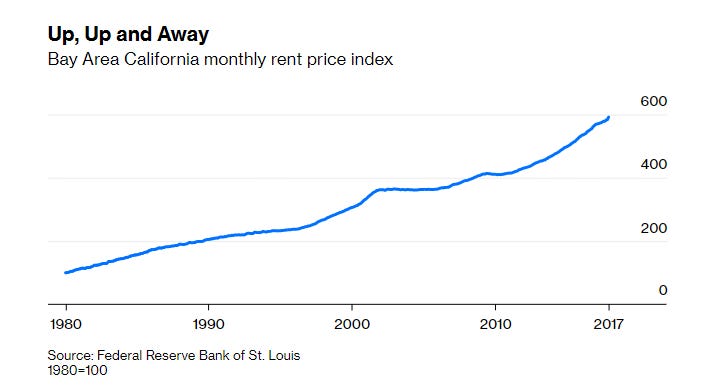Rent control raises rents long term
A look at research from Stanford GSB Economic Professor Rebecca Diamond in San Francisco's multi family housing market.
The NYS budget was released with close to nothing on housing development (*deep sigh*), but the silver lining for many is that Good Cause Eviction also did not come to pass. In that vein, some new research has highlighted that over time, rent controls can increase housing rental prices for newer renters. The research is interesting and could be used as a tool as RSA / CHIP attempt to take their 2019 HSTPA lawsuit to the Supreme Court.
Context:
In 1979, buildings with 5+ apartments in San Francisco, CA became subject to rent control, except for newer buildings, built after 1980 because the city government didn’t want to deter new development. In 1995, this law was tightened. Smaller buildings with 2-4 apartments would now also become rent controlled. The exemption for buildings-built post 1980 remained. Stanford Economics Professor Rebecca Diamond and her team performed a comprehensive study looking at tenant moving patterns, rent growth in apartments, and landlord responses to rent controls. Unlike other studies, there was comprehensive tenant data for this experiment and the way buildings were distributed across the city (rent controlled or not) was random, so this worked great for a science experiment. Her research points to some interesting conclusions.
Key insights from her findings:
Investors want to make money: owners of smaller rental buildings do not take the opportunity costs of foregone rent sitting down. Instead of adjusting to conditions, owners of rent controlled buildings would over time look to exit rent control.
Reduction in rental housing: As investors and property owners saw their rents plateau, they became more likely to demolish properties, sell to end users, or to convert properties directly into condos. Doing any of these would eliminate rent control. In doing so, it created a growing pipeline of rental apartments that would be transferred into owner-occupied housing. According to Diamond, something like ~25% of rent controlled housing stock was lost to these alternative uses in San Francisco.
(Short term) Winners: lower income and minority tenants who entered the housing market near when these rules were implemented, who live in high appreciation areas. In other words, people with lower incomes who have been able to pay comparatively less rent win out.
(Long term) Losers: Newer renters, young people living in high appreciation areas. The up-front costs of rent are higher. Because of the thinning rental housing supply and the growing demand for apartments, the initial rent figures are very high. Owners may also choose to set rents high because they know that from then on, future increases will be small (sound familiar?).

These insights show the negative impact that rent controls have had on the rental housing stock in the U.S., but the intention behind the policy may not be bad. The goal of rent control is to stabilize the housing market so residents who once could afford their neighborhood aren’t forced to leave due to their neighborhood getting more popular. The way rent control is applied, Diamond says, is imperfect: it fixes rents uniformly to everyone and in doing so, it “taxes” owners of properties, by capping their profits. This acts as a regressive tax, where the smallest, least profitable owners pay a greater share of the burden.
Diamond suggests taking the good intentions behind rent controls and tweaking them. To this effect, Diamond tries to think of rent control more as an insurance policy against displacement. Unemployment insurance, for instance, is offered to varying degrees and levels based on people’s needs, and the funding for it is paid for by all the residents of a state or city via income taxes. This targeted approach could work better for owners who may find that they are subsidizing the living expenses of upper income tenants, who do not need insurance against displacement. Diamond also recommends divvying up the “tax” required to pay for this “insurance” across the entire housing sector and encouraging the government to heavily contribute to this tax. Right now, rent controlled building owners pay this "anti-displacement insurance tax” entirely on their own by not being able to raise their rents. They subsidize their tenants’ rents, in other words. Encouraging the government to participate in the subsidy could make a lot of sense.
Diamond’s research and her idea is interesting. In NYC, the rent guidelines board (RGB) members are gearing up to duke it out for their annual rent hike vote. That meeting pits owners against their tenants to argue over whether an increase of a few percentage points in rent is merited. This is a pressurized event, rife with tensions and powerful anecdotes from both sides. This could be different if the government were held responsible as a party to help stabilize rents. The government could step up and find ways to both raise rents for owners and contribute to a fund that would enable tenants to continue paying the increasing rents.
PS - Who knew San Francisco’s rent regulation laws so closely mirrored NYC’s?


